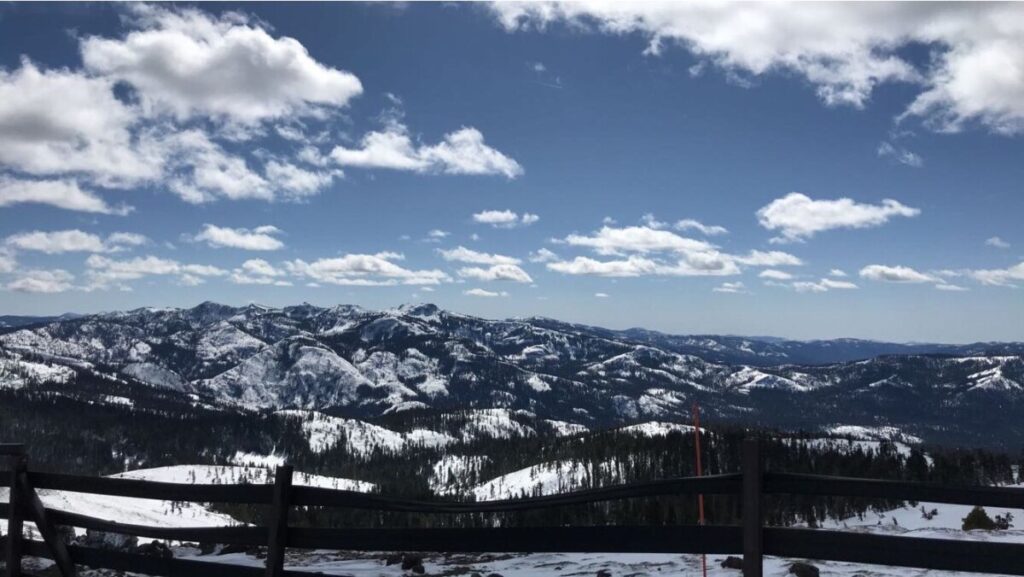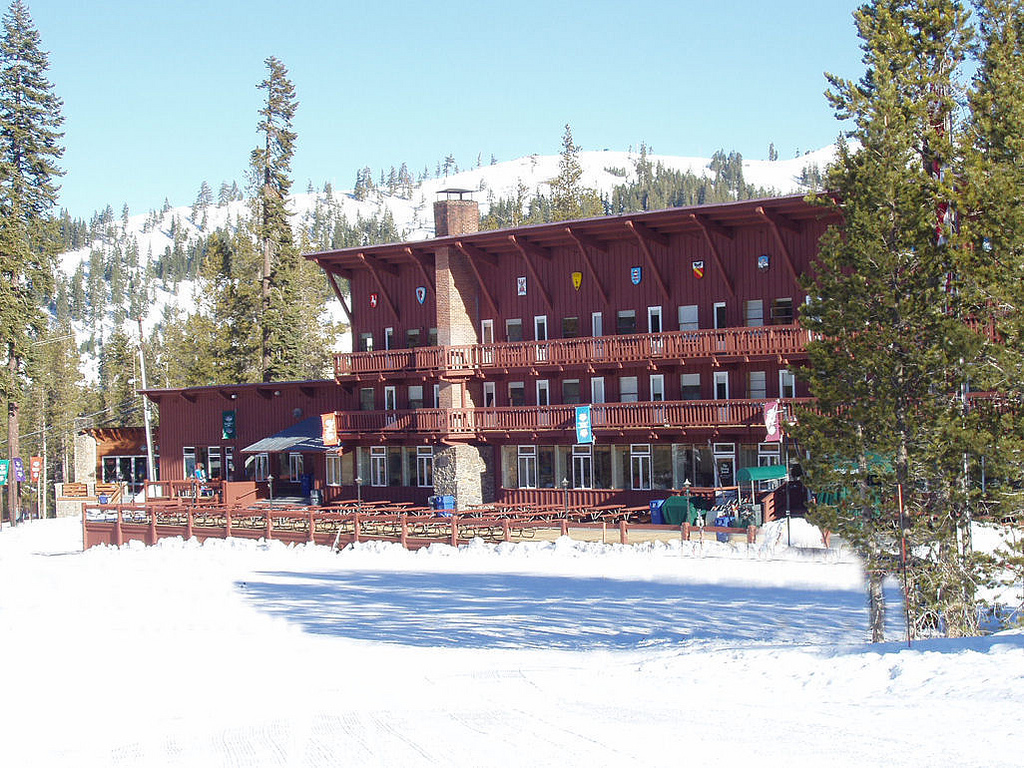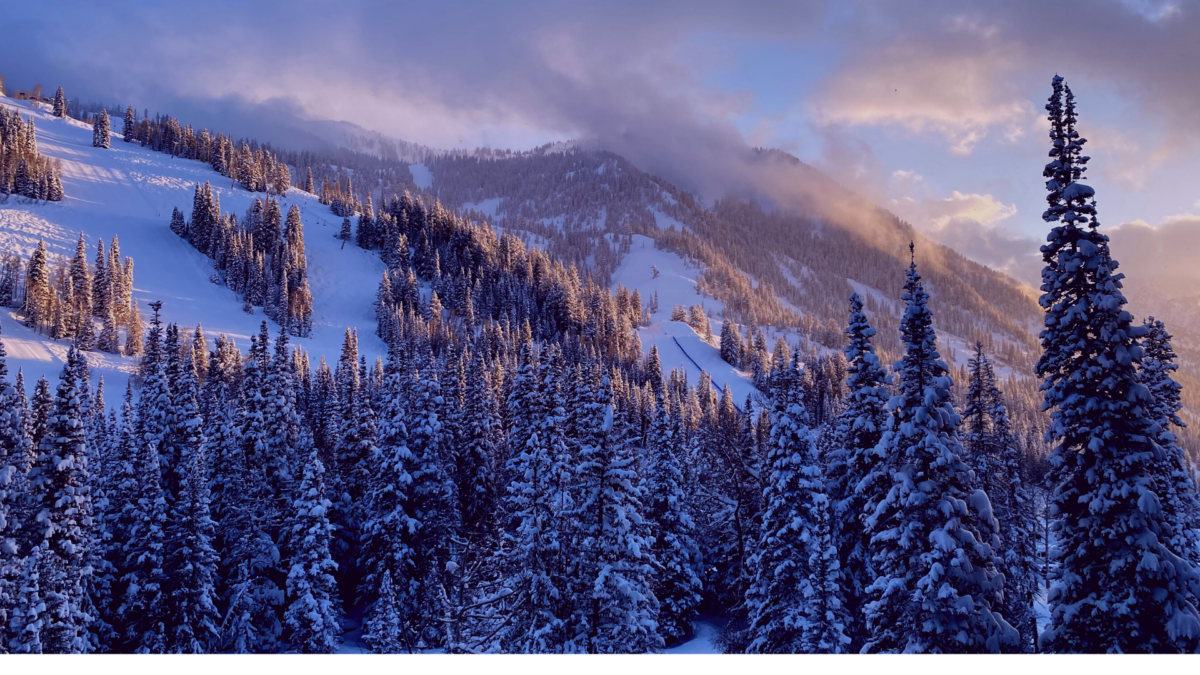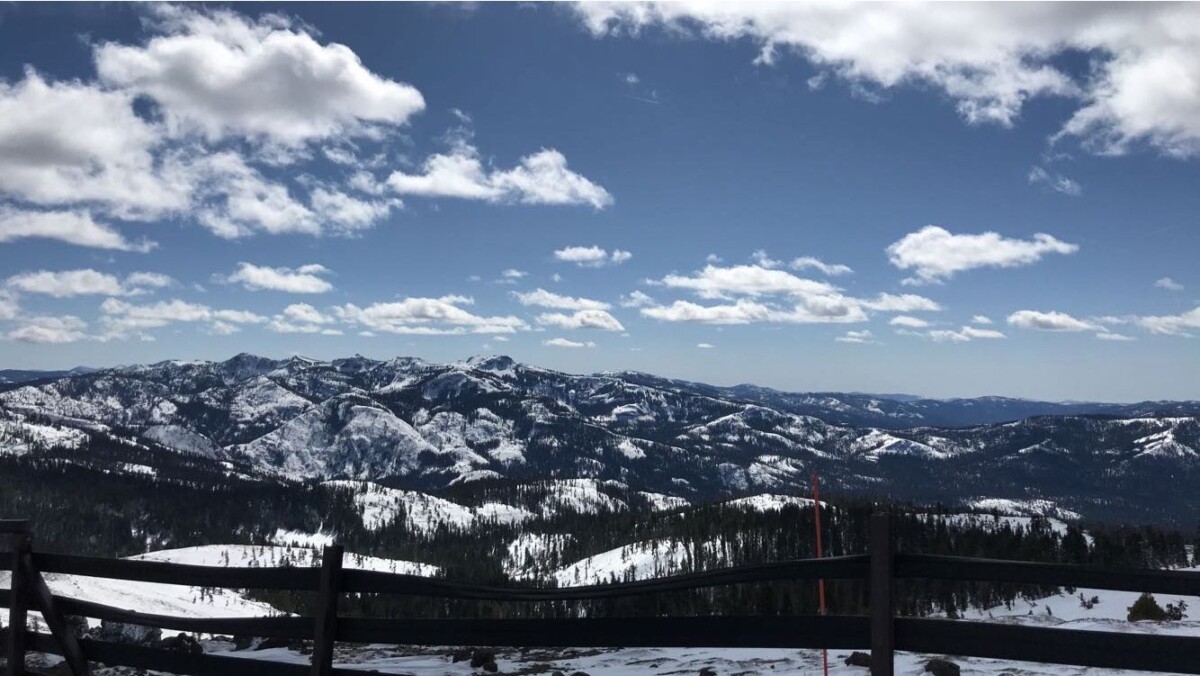There are over a dozen ski resorts in the Lake Tahoe region on the California-Nevada border, where the Sierra Nevada snow draws skiers from near and far. Among these Lake Tahoe-area resorts is Sugar Bowl, which has been in operation since 1939. Sugar Bowl Resort sits atop Donner Summit, with four peaks called Mt. Lincoln, Mt. Disney, Mt. Judah, and Crow’s Nest Peak. Its slopes receive some of the most consistent snow in the region, and as of 2013 the resort averaged 500 inches of snow annually. This is significantly higher than nearby resorts such as Northstar, which averaged 350 inches, Heavenly, which averaged 360 inches, and even Palisades, the former Winter Olympic host, which averaged 450 inches. The resort began with an investment from Walt Disney – Mt. Disney was originally called Hemlock Peak, but renamed in Walt’s honor. Sugar Bowl originally catered to movie stars and the California elite due to its famous associations and desirable snow, and featured some of the best skiing amenities on the West Coast. According to Sugar Bowl Resort’s website, it was the first in California to install a chairlift – aptly named the Disney Lift – and Hollywood guests would travel north to stay at the resort and spend their days skiing and socializing. In 1953, the resort installed the first gondola on the West Coast, which was only the second gondola in all of North America. The director of the resort’s ski school, Bill Klein, was a renowned expert who trained the army’s Tenth Mountain Division skiers during World War II. Klein was described by historian Michael Makley as having been “brought from Austria” in the late 1930s specifically to teach skiing on Mount Lincoln.
These luxuries, paired with the resort’s high snowfall, attracted an elite clientele to Sugar Bowl. Reflecting on the resort’s history, local newspaper The Union described how Sugar Bowl was “an exclusive getaway for a few wealthy Californians” with “a glamorous mountain environment that attracted movie stars [and] famous skiers.” In his The Story of Modern Skiing, John Fry described how Sugar Bowl “lured a scintillating mix of San Francisco society and movie VIPs” as both guests and investors. And according to the Tahoe Daily Tribune, celebrities including Greta Garbo, Charlie Chaplin, Errol Flynn, Janet Leigh, and Claudette Colbert spent time at the resort, as, unsurprisingly, did Walt Disney himself. Disney brought his family on ski trips to Sugar Bowl, and according to Jeffrey Pepper with the Walt Disney Family Museum, also sponsored ski races for children at the resort such as the Disney Junior Challenge Trophy and the Sugar Bowl Perpetual Goofy Races. Disney also featured Sugar Bowl in the 1941 video short “The Art of Skiing” in which classic cartoon character Goofy goes skiing at the resort, characteristically losing control and skiing through the window of an animated version of the Sugar Bowl Lodge, which is labeled as such in the film. More recently, in the 1970s, renowned ski filmmaker Warren Miller filmed parts of his “The Color of Skiing” at Sugar Bowl, and sponsored a ski jumping competition while working there.
However, nearly 85 years after its founding, the resort has gone from the playground of the Hollywood elite to a ski resort primarily visited by local day skiers and visitors from Northern California, rather than from the Southern part of the state. On its website page about getting to Sugar Bowl, it advertises itself as “Northern California’s most accessible resort” for its proximity to Sacramento and the Bay Area. It has maintained its desirable snowfall and impressive trail and lift offerings, while simultaneously becoming increasingly accessible to non-elites. As a whole, Sugar Bowl offers cheaper lift tickets than neighboring resorts, and features local discounts including those aimed at getting more young people on the mountain. But how did this change come to be?

A New Focus
One part of the answer is a specific focus on catering to local and day skiers. This focus has allowed Sugar Bowl Resort to pivot their primary platform from the limited California elite to the local and regional masses. When Rob Kautz took over as the resort’s CEO in 1987, Sugar Bowl was struggling financially. As he described in a 2014 interview with the Tahoe Daily Tribune, Kautz realized at that time that the resort needed to “re-position [itself] in the market.” This repositioning involved improving the infrastructure for day skiers and beginners. Kautz, who joined Sugar Bowl’s ski patrol out of college in 1976 and went on to become the ski patrol’s director before moving onto the position of mountain manager and eventually resort CEO, was intimately familiar with the workings of the resort. He had first begun skiing at Sugar Bowl while in college, and recognized the need to cater to a wider local customer base. His so-called “master plan” to revitalize the resort included the creation of the Mt. Judah Day Lodge, a learning center, and three new chairlifts on the Judah side of the resort. It took nearly twenty years, but all of the planned improvements came to fruition. In a 2005 interview with The Union, Kautz described how the master plan upgrades had all been implemented between 1994 and 2005, at a cost of over $30 million. These upgrades allowed them to “better cater” to a specific “clientele…critical to the success of the resort.” That specific clientele? The day skier.
Mt. Judah Day Lodge, part of the master plan improvements, opened in 1998 “to expand services to day skiers” by providing a new meal spot and rest location on the mountain, and by opening access to more intermediate-level terrain for less experienced skiers. These benefits helped make the resort more appealing to day skiers, which Kautz recognized as a valuable customer group, the potential growth of which could help Sugar Bowl out of its worrying financial situation. By 2005, when all of the original master plan goals had been met, a new wave of improvements was already required to meet the needs of the ever-growing number of day skiers. For example, The Union reported on the addition of 12,000 square feet of cafeteria space onto Mt. Judah Day Lodge between 2006 and 2007 to meet lunchtime demands.
“Not a Village”
Another aspect of the resort that aligns with the focus on day skiers is Sugar Bowl’s lack of retail. In recent years, there has been a large focus on making ski resorts about more than just skiing. Amenities like specialty retail shops, restaurants, ice skating, and movie theaters line resort village streets to encourage guests to visit even if they don’t ski, or only want to ski for a fraction of the day. But Sugar Bowl has avoided this approach. When the resort put in a handful of condos, it was made clear that they were purely housing for customers who wanted to live closer to the slopes, rather than an area for shopping and socializing. In a 2005 interview with The Union while the condo project was in development, the director of resort planning Christopher Parker emphasized that the development was “not a village” and that it was “not going to have chocolate and dog leash shops on the bottom.” This comment, poking fun at the frivolous luxury shops that populate many ski resort villages, is reflective of Sugar Bowl’s position as a whole. The project described above ended up with only 1,905 square feet of retail space, which was filled by the Village Ski & Sports ski shop and tuning center. The only two shopping locations Sugar Bowl advertises, in fact, are Village Ski & Sports and Mt. Judah Ski & Sports, both of which solely sell winter sports gear and a handful of everyday items like sunscreen and hand warmers that visitors might need. This contrasts with nearby Northstar Resort’s village developed around the same time, which according to The Union features 100,000 square feet of commercial space. While Sugar Bowl does have a few restaurants, its focus is overwhelmingly on the ski experience rather than these extras. In a 2013 interview with the Wall Street Journal, Kautz described how other resorts “have big villages and are focused on the destination market” while Sugar Bowl prioritizes the “authentic alpine experience” which “isn’t about villages and amenities but the mountain.” A year later, speaking with the Tahoe Daily Tribune, chairwoman of the Sugar Bowl Corporation Nancy Bechtle described how there were “no shopping and no movie theaters” at Sugar Bowl, because the point of being there was the mountain. This lack of retail development allows Sugar Bowl to allocate its funds elsewhere, such as the Mt. Judah Day Lodge project. It also means that those who come to Sugar Bowl come for the mountain, exactly what day skiers are doing, while potentially discouraging overnight guests who would rather stay somewhere with more activity options off of the slopes.

The Results
These active decisions to cater towards day skiers have made a noticeable impact on Sugar Bowl’s clientele. According to a 2013 Wall Street Journal interview with Kautz, 50% of Sugar Bowl skiers both “leave from and return to their primary residence” on days they ski there. In other words, half of the resort’s skiers are now day skiers living within driving distance of Sugar Bowl. This includes both Sacramento and the San Francisco Bay Area, and as of 2014, 85% of Sugar Bowl skiers came from these two areas. Bruce Closser describes in his article “Appraising the Ski Area” in the Appraisal Journal that “proximity to population centers” is important for all ski resorts, but especially for a “day area” like Sugar Bowl. While some skiers from these areas may come for multiple days of skiing and spend one or multiple nights in the Tahoe area, most visit Sugar Bowl from their permanent residence and return there at the end of the day. Arriving by car, they can take advantage of Sugar Bowl’s three free parking lots, another feature which makes the resort more accessible by lowering costs for customers.
While the vast majority of Sugar Bowl’s skiers come from Sacramento and the Bay Area, the resort caters to skiers from its own county as well. According to its website, Sugar Bowl Resort offers an unrestricted season pass for local K-12 students for only $199, a much lower price than any other offered season pass. As of April 2023, the pricing for the upcoming 2023-2024 ski season has this local student pass sitting at $300 cheaper than the regular children’s passes, and $560 cheaper than the regular young adult passes, which encompass the high school age group. This affordable pass, which Truckee-area newspaper the Sierra Sun describes as being new for the upcoming season, makes the resort increasingly accessible to local skiers. It also helps the resort foster a culture of skiing among local youth, which supports their client base into the future.
Overall, Sugar Bowl Resort changed from a resort catering primarily to Hollywood elites and famous skiers to a resort accessible to local populations and snowsports beginners by making choices that cater specifically to day skiers. Resort leadership under CEO Rob Kautz focused on improvements that elevated the day skier experience, such as expanding cafeteria space, building more lifts, and increasing accessibility to easier terrain for lower-level skiers. They also implemented programs such as the local student pass to encourage skiing among those who might not otherwise participate in the sport, and strayed away from industry norms surrounding retail-focused villages in order to prioritize improvements to the ski and mountain experience instead. While the legacy of its Hollywood origins lives on with ski runs including Disney Nose, Disney Traverse, Disney Return, Disney Meadow, and Donald Duck, the overall culture of Sugar Bowl has changed to one focused more on Northern California day skiers than celebrity glamor and long-distance visitors.
Works Cited
“A family affair – Has Sugar Bowl’s ownership left it trailing other resorts?” The Union. February 24, 2005. https://www.theunion.com/news/local-news/a-family-affair-has-sugar-bowl-s-ownership-left-it-trailing-other-resorts/article_eb099e0a-0760-5b75-bc57-99ac1bfd2908.html
Carlton, Jim. “Sugar Bowl Carves Niche to Compete.” Wall Street Journal. February 6, 2013. https://www.wsj.com/articles/SB10001424127887324900204578283891260615054
Closser, Bruce M. “Appraising the Ski Area.” Appraisal Journal 48, no. 3 (July 1980): 325-337. https://search-ebscohost-com.proxy.library.emory.edu/login.aspx?direct=true&db=hjh&AN=5363539&site=ehost-live&scope=site.
Disney. “The Art of Skiing.” Walt Disney Productions, 1941. https://video.disney.com/watch/the-art-of-skiing-4be3880daed0ca0e1266b068
Fry, John. The Story of Modern Skiing. Hanover: University Press of New England, 2006.
Hutner, Priya. “Steeped in Sierra history, iconic Sugar Bowl ski resort embarks on 75th season.” Tahoe Daily Tribune. November 26, 2014. https://www.tahoedailytribune.com/news/steeped-in-sierra-history-iconic-sugar-bowl-ski-resort-embarks-on-75th-season/
Makley, Michael J. A Short History of Lake Tahoe. Reno: University of Nevada Press, 2011.
Pepper, Jeffrey. “New Heights: Mount Disney and Sugar Bowl.” The Walt Disney Family Museum Blog. January 16, 2012. https://www.waltdisney.org/blog/new-heights-mount-disney-and-sugar-bowl
Sugar Bowl Resort. “History.” Accessed April 17, 2023. https://www.sugarbowl.com/history
“Sugar Bowl Resort launches 2023-24 season passes with new deals” Sierra Sun. March 10, 2023. https://www.sierrasun.com/news/sugar-bowl-resort-launches-2023-24-season-passes-with-new-deals/
Sugar Bowl Resort. “Directions.” Accessed April 24, 2023. https://www.sugarbowl.com/directions
Sugar Bowl Resort. “Lift Tickets.” Accessed April 17, 2023. https://www.sugarbowl.com/tickets
Sugar Bowl Resort. “Season Passes.” Accessed April 17, 2023. https://www.sugarbowl.com/seasonpass
Sugar Bowl Resort. “Shopping.” Accessed April 24, 2023. https://www.sugarbowl.com/shopping
Sugar Bowl Resort. “Sugar Bowl Parking Guide.” Accessed April 24, 2023. https://www.sugarbowl.com/18703
Sugar Bowl Resort. “Trail Maps.” Accessed April 24, 2023. https://www.sugarbowl.com/trailmaps

